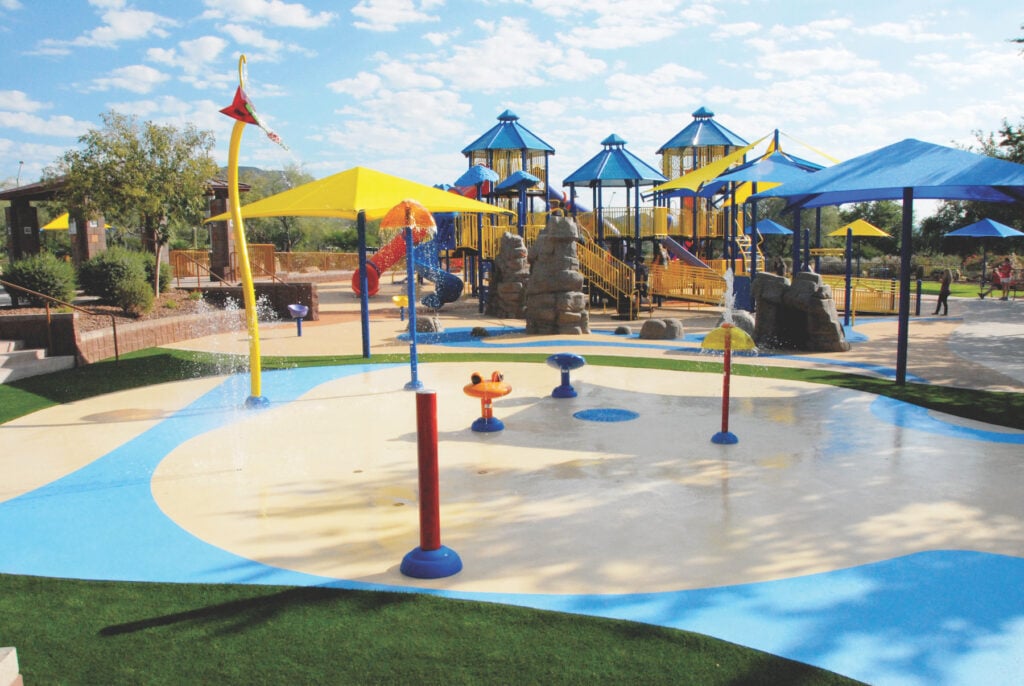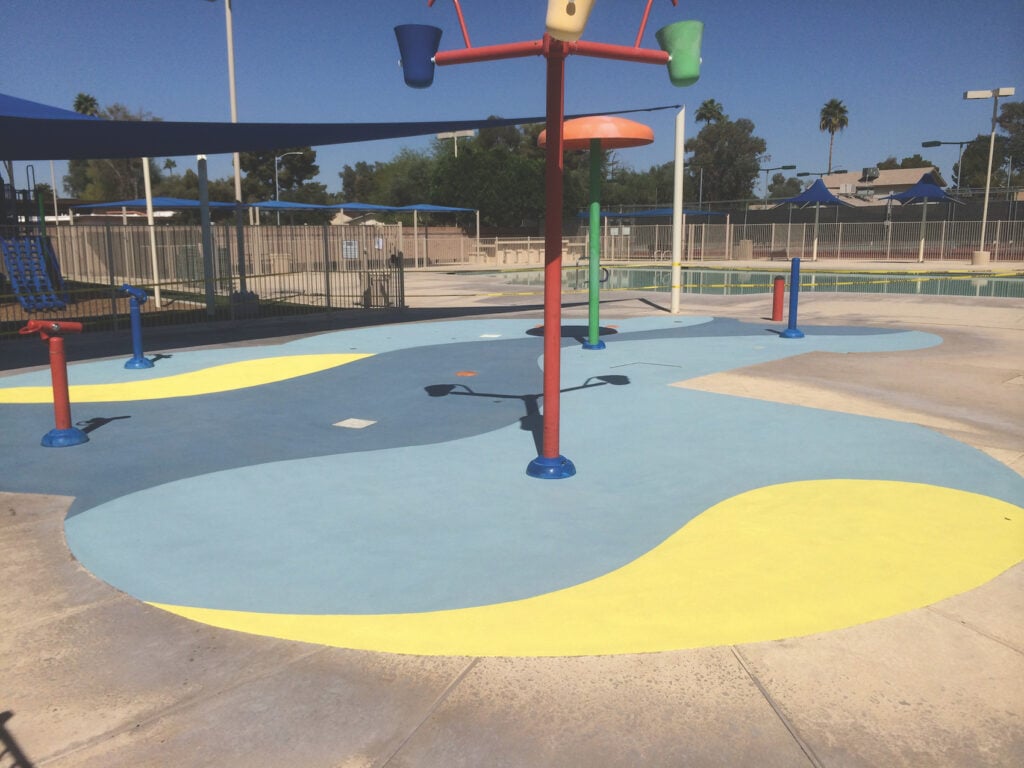Choosing the right surfacing is important when it comes to creating a fun and safe environment for water parks and splash pads. The surface needs to be durable, slip-resistant, and able to withstand constant exposure to UV rays, water, and heavy foot traffic. Luckily, there are several excellent options available that meet these requirements.
Factors to Consider When Choosing Surfacing
Before selecting the ideal surfacing for your aquatic park, there are several crucial factors to consider. By carefully evaluating these factors, you can ensure that your water play area is not only enjoyable but also prioritizes safety, durability, and aesthetics. Take the following aspects into account, and you'll be on the right path to creating a vibrant and secure environment for all visitors to enjoy their water park experience to the fullest.
Safety Considerations
When it comes to water play, safety should always be the top priority. Water play areas are prone to wet and slippery conditions, making it essential to select a surface that provides adequate traction and minimizes the risk of accidents or injuries. One of the key aspects to keep in mind is the slip resistance of the surfacing material. Opting for a surfacing material that is resistant to fading, cracking, and deterioration ensures longevity and reduces maintenance costs over time.
Maintenance and Durability
By carefully considering maintenance and durability as part of your selection process, you can ensure that your aquatic surfacing choice remains safe, attractive, and functional for years to come. Maintenance plays a vital role in preserving the longevity and functionality of aquatic surfacing. Additionally, durable surfacing materials are essential for withstanding heavy foot traffic, water exposure, and other environmental factors commonly found in water play areas.
Design and Aesthetics
Choosing the right design and aesthetics for aquatic surfacing can enhance the overall experience and make it more enjoyable for children. It is essential to select colors, patterns, and textures that are visually appealing and complement the theme or concept of the water play area. Additionally, incorporating elements such as vibrant colors, playful patterns, and interactive features can stimulate children's imagination and encourage active participation. The design should be inviting, visually stimulating, and create a sense of excitement that will captivate young minds.
Types of Aquatic Surfacing Options
Create a safe and visually appealing environment for water parks and splash pads by choosing the right surfacing option. From the durability of concrete to the comfort of rubberized surfaces, understanding the different surfacing options will help you make an informed decision that aligns with your specific needs and priorities. So, let's dive into the world of aquatic surfacing options and discover the perfect choice for your water park or splash pad.
Rubberized Surfaces

Rubberized surfaces have gained popularity as a suitable option for splash pads and water parks due to their numerous advantages. However, like any surfacing material, they also come with a few drawbacks. Let's take a closer look at the pros and cons of rubberized surfaces for these aquatic facilities.
Pros of Rubberized Surfaces
- Safety: Rubberized surfaces offer excellent slip resistance, reducing the risk of accidents caused by wet conditions. They provide traction, even when wet, making them ideal for splash pads and areas where water play is involved. This helps ensure a safer environment for visitors of all ages.
- Impact Absorption: Rubberized surfaces have cushioning properties that can absorb the impact of falls and reduce the severity of injuries. This is especially important in areas where children play and may be prone to slips and falls. The softness of rubber helps minimize the risk of serious injuries.
- Comfort: Rubber surfaces are generally comfortable to walk on, providing a softer and more forgiving feel compared to harder materials like concrete. This comfort factor enhances the overall visitor experience, allowing them to enjoy their time at the water park or splash pad for longer durations.
- Versatility: Rubberized surfaces can be customized in terms of colors, patterns, and designs, allowing for creative and visually appealing splash pad or water park themes. They offer a wide range of possibilities for customization and can be tailored to match the desired aesthetic of the facility.
Cons of Rubberized Surfaces
- Heat Absorption: Rubber can absorb and retain heat, making the surface hot to the touch on sunny days. This can be a concern in areas with high temperatures, potentially leading to discomfort for barefoot visitors. It's essential to select rubberized surfaces that have heat-resistant properties or incorporate cooling technologies to mitigate this issue.
- Cost: Rubberized surfaces can be more expensive than some other surfacing options, such as concrete. The initial installation costs may be higher, particularly for larger water park or splash pad areas. However, it's important to consider the long-term benefits and durability of rubberized surfaces when evaluating their overall cost-effectiveness.
Understanding the pros and cons of rubberized surfaces for splash pads and water parks can help you make an informed decision based on the specific needs and priorities of your facility. Considering factors such as safety, comfort, maintenance requirements, and budget will ensure you select the most suitable surfacing option for your aquatic environment.

Concrete
Concrete surfaces for water play areas offer a long-lasting solution that requires minimal repairs or replacement, resulting in cost savings over time. Despite its potential for slipperiness when wet, concrete remains a favored choice for aquatic surfacing. Explore the advantages and disadvantages below to see if it’s right for your facility.
Pros of Concrete Surfaces
- Durability: Concrete is known for its durability and ability to withstand heavy foot traffic and exposure to water. It is a long-lasting material that can withstand the rigors of constant use in a water park or splash pad environment. Properly installed and maintained concrete surfaces can provide years of reliable service.
- Cost-Effectiveness: Concrete surfaces tend to be more cost-effective compared to some other surfacing options. The material itself is relatively affordable, and the installation process is straightforward. Concrete's durability also means that it requires minimal repairs or replacement, further reducing long-term costs.
- Ease of Maintenance: Concrete surfaces are relatively easy to clean and maintain. Regular sweeping, occasional pressure washing, and sealing can help keep the surface clean and prevent the growth of algae or other contaminants. This makes it easier to maintain a clean and hygienic environment for visitors.
Cons of Concrete Surfaces
- Slipperiness: One of the main drawbacks of concrete surfaces is their potential to become slippery when wet. Water on a smooth concrete surface can create a hazardous condition, increasing the risk of slips and falls. However, anti-slip additives or surface treatments can be applied to enhance traction and reduce slipperiness.
- Heat Retention: Concrete tends to absorb and retain heat, making the surface hot to the touch, especially in sunny and warm climates. This can be uncomfortable for barefoot visitors, particularly children, and may limit their enjoyment of the splash pad or water park. Providing shaded areas or incorporating cooling techniques can help mitigate this issue.
- Lack of Cushioning: Concrete surfaces are firm and unforgiving, offering little to no cushioning or impact absorption. In areas where falls are likely, such as splash pads with water features, this can increase the risk of injuries. Adding impact-absorbing materials or installing additional padding may be necessary to improve safety.
- Design Limitations: While concrete can be customized to a certain extent, it may not provide the same level of design versatility as other surfacing options. Achieving intricate patterns or textures may require additional effort and expense. If a specific aesthetic or theme is a high priority, other materials might offer more flexibility in terms of design options.
By addressing potential challenges like slipperiness and heat retention through appropriate modifications, you can maximize the benefits of concrete's durability, cost-effectiveness, and ease of maintenance. Ultimately, the choice of surfacing material should align with your priorities for safety, aesthetics, and long-term performance.
Artificial Turf
Artificial turf is a popular surfacing option for splash pads and water parks due to its unique advantages. However, it also has a few drawbacks to consider. Let's explore the pros and cons of using artificial turf as a surface for these aquatic facilities:
Pros of Artificial Turf:
- Safety: Artificial turf provides a relatively soft and forgiving surface, reducing the risk of injuries from slips and falls. It offers better impact absorption compared to harder surfaces like concrete, making it safer for children and visitors of all ages.
- Comfort: Artificial turf offers a cushioned and comfortable surface to walk or play on. It provides a more forgiving feel underfoot compared to harder materials, allowing visitors to enjoy extended periods of play without discomfort.
- Low Maintenance: Artificial turf requires less maintenance compared to natural grass. It doesn't need mowing, watering, or fertilizing, which can result in significant time and cost savings. Regular brushing and occasional cleaning are usually sufficient to maintain its appearance and functionality.
- Aesthetics: Artificial turf provides a consistently green and visually appealing surface throughout the year. It offers a manicured look and can be customized to match the desired aesthetic of the water park or splash pad. It creates a natural and inviting atmosphere for visitors.
Cons of Artificial Turf:
- Heat Retention: Artificial turf tends to retain heat, especially in sunny and warm climates. The surface can become hot to the touch, potentially causing discomfort for barefoot visitors. Implementing shading elements or cooling techniques can help mitigate this issue.
- Drainage: Proper drainage is crucial for water parks and splash pads. Artificial turf may not offer the same level of natural drainage as other materials. Without adequate design and installation considerations, it can result in water pooling or inadequate drainage, leading to potential maintenance issues.
- Lifespan: Although artificial turf is durable, its lifespan may be shorter compared to some other surfacing options. Constant exposure to water, sunlight, and heavy use can cause wear and tear over time. Regular inspection, maintenance, and eventual replacement may be necessary to ensure optimal functionality.
Where to Buy Aquatic Surfacing for Water Play Areas
In the end, selecting the best surfacing for water parks and splash pads is about striking the right balance between safety, functionality, and aesthetics. By making thoughtful choices and staying up to date with industry developments, you can create a vibrant and engaging aquatic facility that promises memorable experiences and endless water-filled fun for visitors of all ages.
If you’re ready to make a splash with the perfect surfacing for your aquatic facility, discover the expertise and options available at FlexGround! We have multiple rubberized aquatic surfacing options for water play areas.
Take the next step towards creating a safe, attractive, and unforgettable aquatic environment. Contact us today to discuss your project and request a consultation.

